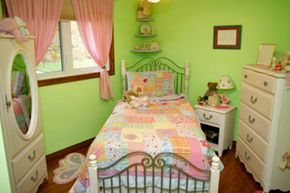Kids' furniture has to fulfill some lofty requirements, and we aren't just talking about loft beds, either. From safety issues to concerns about durability, style, comfort and price, dressing up a child's room can be as much fun as you thought, but way more work than you expected.
From a practical perspective, kids' furniture isn't just scaled down adult furniture designed for smaller bodies. It has to be able to take a beating without breaking or becoming a hazard in other ways. It should be held to a higher standard, and it is. The Consumer Products Safety Commission (CPSC) has guidelines for durable goods designed for use by children under the age of 12, including furniture, bedding and toys. It's called the Consumer Product Safety Improvement Act (CPSIA).
Advertisement
It provides an extra level of protection that can help ensure that the products you buy are safe for your child to use. It should also be a heads-up, though. These protections are in place because children are more vulnerable than adults. Furniture made from flimsy materials, sporting sharp edges or with loose components that can shift unexpectedly may be an inconvenience to an adult but potentially life threatening to a young child. That's one reason why safety tops our list of things to consider when buying kids furniture.
There's something else to think about, too. Children don't just use furniture; they give beds, dressers, chairs, desks and just about everything else a heck of a beating. From trying to climb their cribs as if they were monkey bars (a photo op if ever there was one), to using their beds as trampolines, children punish their furnishings. That's one reason to make sure the furniture you buy for a young child's room is designed for a child. The sizing will be right, and the design will likely be sound, sturdy and safe.
Although we'll get to some specific guidelines for shopping for kids furniture in a second, your best resource is always your intuition. Purchase from manufacturers you trust, and inspect what you buy for flaws in workmanship. Read the promotional materials carefully, too. Every year, there are recalls on dozens of kids' products, the result of injuries and even fatalities sustained from using unsafe goods. Stay informed, but don't stop there. If you have questions, contact the manufacturer to ask for more information. If anything seems off, don't buy the product, and report your suspicions to the CPSC via its Safe Products Page.
Let's take a look at some tips and a few warnings about buying kid stuff. Don't worry; it isn't all doom and gloom. There are some amazing, versatile and beautifully designed products out there that can transform a kid's room into a retreat worthy of Aladdin and his cave of wonders.
Advertisement



